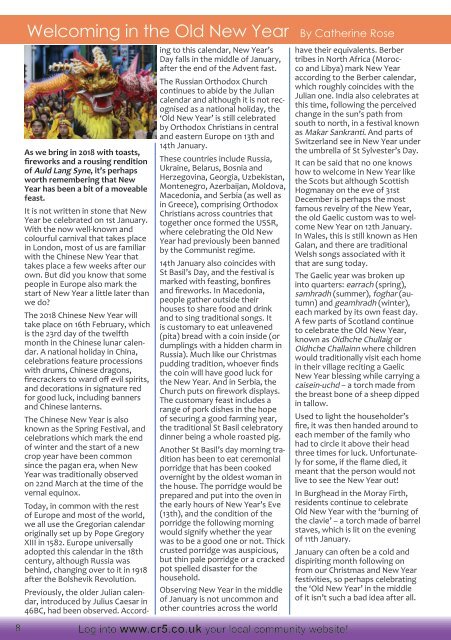CR5 Issue 152 Jan 2018
A local community magazine containing business advertising, interesting reads, What's On in the area and puzzles
A local community magazine containing business advertising, interesting reads, What's On in the area and puzzles
Create successful ePaper yourself
Turn your PDF publications into a flip-book with our unique Google optimized e-Paper software.
Welcoming in the Old New Year By Catherine Rose<br />
As we bring in <strong>2018</strong> with toasts,<br />
fireworks and a rousing rendition<br />
of Auld Lang Syne, it’s perhaps<br />
worth remembering that New<br />
Year has been a bit of a moveable<br />
feast.<br />
It is not written in stone that New<br />
Year be celebrated on 1st <strong>Jan</strong>uary.<br />
With the now well-known and<br />
colourful carnival that takes place<br />
in London, most of us are familiar<br />
with the Chinese New Year that<br />
takes place a few weeks after our<br />
own. But did you know that some<br />
people in Europe also mark the<br />
start of New Year a little later than<br />
we do?<br />
The <strong>2018</strong> Chinese New Year will<br />
take place on 16th February, which<br />
is the 23rd day of the twelfth<br />
month in the Chinese lunar calendar.<br />
A national holiday in China,<br />
celebrations feature processions<br />
with drums, Chinese dragons,<br />
firecrackers to ward off evil spirits,<br />
and decorations in signature red<br />
for good luck, including banners<br />
and Chinese lanterns.<br />
The Chinese New Year is also<br />
known as the Spring Festival, and<br />
celebrations which mark the end<br />
of winter and the start of a new<br />
crop year have been common<br />
since the pagan era, when New<br />
Year was traditionally observed<br />
on 22nd March at the time of the<br />
vernal equinox.<br />
Today, in common with the rest<br />
of Europe and most of the world,<br />
we all use the Gregorian calendar<br />
originally set up by Pope Gregory<br />
XIII in 1582. Europe universally<br />
adopted this calendar in the 18th<br />
century, although Russia was<br />
behind, changing over to it in 1918<br />
after the Bolshevik Revolution.<br />
Previously, the older Julian calendar,<br />
introduced by Julius Caesar in<br />
46BC, had been observed. According<br />
to this calendar, New Year’s<br />
Day falls in the middle of <strong>Jan</strong>uary,<br />
after the end of the Advent fast.<br />
The Russian Orthodox Church<br />
continues to abide by the Julian<br />
calendar and although it is not recognised<br />
as a national holiday, the<br />
‘Old New Year’ is still celebrated<br />
by Orthodox Christians in central<br />
and eastern Europe on 13th and<br />
14th <strong>Jan</strong>uary.<br />
These countries include Russia,<br />
Ukraine, Belarus, Bosnia and<br />
Herzegovina, Georgia, Uzbekistan,<br />
Montenegro, Azerbaijan, Moldova,<br />
Macedonia, and Serbia (as well as<br />
in Greece), comprising Orthodox<br />
Christians across countries that<br />
together once formed the USSR,<br />
where celebrating the Old New<br />
Year had previously been banned<br />
by the Communist regime.<br />
14th <strong>Jan</strong>uary also coincides with<br />
St Basil’s Day, and the festival is<br />
marked with feasting, bonfires<br />
and fireworks. In Macedonia,<br />
people gather outside their<br />
houses to share food and drink<br />
and to sing traditional songs. It<br />
is customary to eat unleavened<br />
(pita) bread with a coin inside (or<br />
dumplings with a hidden charm in<br />
Russia). Much like our Christmas<br />
pudding tradition, whoever finds<br />
the coin will have good luck for<br />
the New Year. And in Serbia, the<br />
Church puts on firework displays.<br />
The customary feast includes a<br />
range of pork dishes in the hope<br />
of securing a good farming year,<br />
the traditional St Basil celebratory<br />
dinner being a whole roasted pig.<br />
Another St Basil’s day morning tradition<br />
has been to eat ceremonial<br />
porridge that has been cooked<br />
overnight by the oldest woman in<br />
the house. The porridge would be<br />
prepared and put into the oven in<br />
the early hours of New Year’s Eve<br />
(13th), and the condition of the<br />
porridge the following morning<br />
would signify whether the year<br />
was to be a good one or not. Thick<br />
crusted porridge was auspicious,<br />
but thin pale porridge or a cracked<br />
pot spelled disaster for the<br />
household.<br />
Observing New Year in the middle<br />
of <strong>Jan</strong>uary is not uncommon and<br />
other countries across the world<br />
8 Log into www.cr5.co.uk your local community website!<br />
have their equivalents. Berber<br />
tribes in North Africa (Morocco<br />
and Libya) mark New Year<br />
according to the Berber calendar,<br />
which roughly coincides with the<br />
Julian one. India also celebrates at<br />
this time, following the perceived<br />
change in the sun’s path from<br />
south to north, in a festival known<br />
as Makar Sankranti. And parts of<br />
Switzerland see in New Year under<br />
the umbrella of St Sylvester’s Day.<br />
It can be said that no one knows<br />
how to welcome in New Year like<br />
the Scots but although Scottish<br />
Hogmanay on the eve of 31st<br />
December is perhaps the most<br />
famous revelry of the New Year,<br />
the old Gaelic custom was to welcome<br />
New Year on 12th <strong>Jan</strong>uary.<br />
In Wales, this is still known as Hen<br />
Galan, and there are traditional<br />
Welsh songs associated with it<br />
that are sung today.<br />
The Gaelic year was broken up<br />
into quarters: earrach (spring),<br />
samhradh (summer), foghar (autumn)<br />
and geamhradh (winter),<br />
each marked by its own feast day.<br />
A few parts of Scotland continue<br />
to celebrate the Old New Year,<br />
known as Oidhche Chullaig or<br />
Oidhche Challainn where children<br />
would traditionally visit each home<br />
in their village reciting a Gaelic<br />
New Year blessing while carrying a<br />
caisein-uchd – a torch made from<br />
the breast bone of a sheep dipped<br />
in tallow.<br />
Used to light the householder’s<br />
fire, it was then handed around to<br />
each member of the family who<br />
had to circle it above their head<br />
three times for luck. Unfortunately<br />
for some, if the flame died, it<br />
meant that the person would not<br />
live to see the New Year out!<br />
In Burghead in the Moray Firth,<br />
residents continue to celebrate<br />
Old New Year with the ‘burning of<br />
the clavie’ – a torch made of barrel<br />
staves, which is lit on the evening<br />
of 11th <strong>Jan</strong>uary.<br />
<strong>Jan</strong>uary can often be a cold and<br />
dispiriting month following on<br />
from our Christmas and New Year<br />
festivities, so perhaps celebrating<br />
the ‘Old New Year’ in the middle<br />
of it isn’t such a bad idea after all.

















